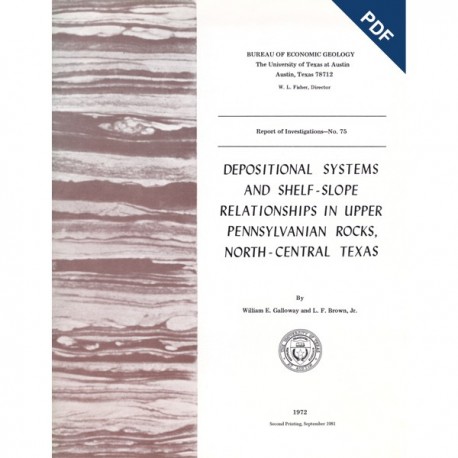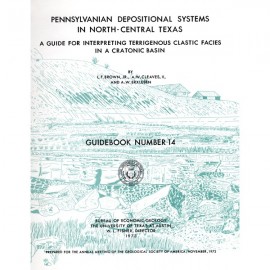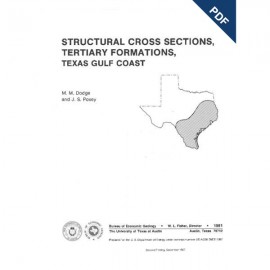Reports of Investigations
-
Books & Reports
- Reports of Investigations
- Guidebooks
- Udden Series
- Geological Circulars
- Down To Earth
- Atlases of Major Oil and Gas Reservoirs
- Texas Memorial Museum Publications
- Environmental Geologic Atlas of the Texas Coastal Zone
- Mineral Resource Circulars
- Other Reports
- Seminars and Workshops
- Handbooks
- Submerged Lands of Texas
- Symposia
- Annual Reports
- Open File Reports
-
Maps & Cross Sections
- Thematic Maps
- Miscellaneous Maps, Charts & Sections
- Geologic Atlas of Texas
- STATEMAP Project Maps
- Geologic Quadrangle Maps
- Cross Sections
- Highway Geology Map
- Energy and Mineral Resource Maps
- Shoreline Change and Other Posters
- Wilcox Group, East Texas, Geological / Hydrological Folios
- Bouguer Gravity Atlas of Texas
- River Basin Regional Studies
- Featured Maps
- Posters
- Teachers & the Public
-
Geological Society Publications
- Gulf Coast Association of Geological Societies
- Alabama Geological Society
- Austin Geological Society
- Corpus Christi Geological Society
- Houston Geological Society
- Lafayette Geological Society
- Mississippi Geological Society
- New Orleans Geological Society
- South Texas Geological Society
- GCS SEPM Publications
- Historic BEG & UT Series

Depositional Systems and Shelf-Slope Relationships in... Pennsylvanian Rocks, North-Central Texas. Digital Download
RI0075D
A free, digital version of this publication can be found on: Texas ScholarWorks
To purchase a print version (if available): RI0075
RI0075D. Depositional Systems and Shelf-Slope Relationships in Upper Pennsylvanian Rocks, North-Central Texas, by W. E. Galloway and L. F. Brown, Jr. 62 p., 31 figs., 5 plates, 1972. doi.org/10.23867/RI075D. Downloadable PDF.
To purchase this publication in book format, please order RI0075.
ABSTRACT
The Eastern Shelf was a constructional platform developed on the margin of the sediment-starved Midland Basin during Late Pennsylvanian and Early Permian time. A mixed terrigenous-carbonate sedimentary province characterized the shelf during most of its history. Sediments were derived from highlands to the east and northeast. Along the outcrop in Eastland, Stephens, Young, and Jack counties, uppermost Pennsylvanian beds comprise the Harpersville Formation, a boundary-defined rock stratigraphic unit within the Cisco Group. Harpersville facies extend westward into the subsurface 50 to 60 miles, where they grade into equivalent shelf margin carbonate and slope terrigenous facies. Preserved relief between the shelf margin and basin floor ranges from 600 to 1,100 feet with dips up to 5 degrees.
Three component depositional systems, recognized on the basis of gross lithologic composition and position relative to the shelf edges, are the Cisco fluvial-deltaic system, the Sylvester shelf-edge bank system, and the Sweetwater slope system. The Cisco fluvial-deltaic system is composed of dipfed fluvial-deltaic facies and associated strike-fed interdeltaic embayment facies. Eight deltaic lobes have been mapped. The Sweetwater slope system is composed of several slope wedges, or fans, each of which includes shelf margin, slope trough, and distal slope sandstone facies, as well as slope mudstone facies. Terrigenous sediments were transported across the shelf by prograding fluvial-deltaic channels that locally extended through the Sylvester shelf-edge bank system and onto the slope where deposition in the deeper basin constructed submarine fans.
The Eastern Shelf prograded into the Midland Basin through contemporaneous, local upbuilding by fluvial, deltaic, and shelf-edge bank deposition and outbuilding by slope-fan deposition. Sites of shelf construction or outbuilding shifted through time in response to sedimentary and structurally controlled abandonment of major delta lobes. Extrabasinal controls such as eustatic sea-level changes were of secondary importance in developing the depositional fabric of the shelf of the Harpersville Formation.
Keywords: Cisco fluvial-deltaic system, depositional systems, Eastern Shelf, Midland Basin, North-Central Texas, Pennsylvanian, Texas
Citation
Galloway, W. E., and Brown, L. F., Jr., 1972, Depositional Systems and Shelf-Slope Relationships in Upper Pennsylvanian Rocks, North-Central Texas: The University of Texas at Austin, Bureau of Economic Geology, Report of Investigations No. 75, 62 p.




